This is our main assignment for this year. For the assignment we are assigned groups and get partnered with the game design students. The project itself is to make a game prototype. We had to work together to create a largely story driven game, using noticeable artistic techniques throughout. The groups comprised of ten or eleven people, five or six from our animation course and five or six from the game course. On the first day we got together in our groups and came up with an idea for what the game would be. We each came up with three or five ideas then presented them among ourselves to find the one we wanted to the to do the most. The top three contenders ended up being an island adventure game where you go from island to island to survive and gather materials and clues to try and escape, a detective game where you would interact with ghosts to try and solve murder mysteries and finally an alien parasite infiltration game. The game we decided to go with was the alien infiltration game. We got to work on the narrative for the game. This turned out to be; a spaceship crew accidently picked up a small part of a large alien hive mind and it started to grow on the spaceship against their knowledge. As the the hive got bigger, it was able to release small spores which have the ability to posses members of the ship’s crew, with their objective being to get to and possess the captain and crash/takeover the whole vessel. Once we had finalized the narrative, we started to work on what the game would look and feel like. We decided one of the main drivers for the tone of the game was the first Alien movie,, so we wanted to try and emulate its grimey and gritty feel as much as possible. What we went with was a low poly game, using hand painted black texture lines (like Border Lands) and a cell shader. After we had established the look and feel of the game, we allocated roles (I will emphasize here how we were given SPECIFIC roles). On the team sheets everyone was given a primary and secondary role each but when the idea was finalized we decided to change that. Due to the fact that the game is low poly, only a few different characters and not much animation apart from walk/run cycles and a few movements such as reaching out to press things, we mostly ditched the secondary roles. For us animators, Lel and Charlotte paired together to be the art directors and create the character models, Jack wanted to do all of the animations and rigs, Stork was assigned to do the texturing after she showed an example she did of the line texture which was really good, I was put on prop/clutter modelling and Amber was put on asset modelling.
We made a discord (our “studio” name being ‘Brain Drain Studios’ not that it matters) with several channels for each different role so we could send updates and communicate about the game. We used the discord to have a team call at least once a week on Wednesday evenings to discuss progress and present any new ideas. On the first call the game ones got us to download and set up GitHub which took a while as none of us had ever used it before. It basically allowed us to work on the Unreal file in our separate channels and then upload our updated unreal file to the main file and combine it with all the edits everyone else was making, so that the game was up to date at all times and nobody was accidentally working on an older version or something like that. Ryan from games adopted a leader role among the group, there was technically no leader but he lead most discussions and presentations in class and was always friendly with the animation people, overall great to work with.
The discord was used to create things such as an asset list which myself and Amber were able to work from over the course of the several weeks that went into creating the game. The sound guy from Coleraine was also added to the discord and we were able to talk with him about the score for the game. The score we decided on (so as to give him less work and to show the player’s progress in the game) just one main score, but it would build up as the player infected more of the crew. So for example it may start off with just piano then after one infection a bass is added, then drums then guitar and so on.
The total number of different assets I provided to the final project was seven. These were presented over the weeks to the game students who were happy with what I had provided.
I actually ended up learning a handful of new techniques on Maya while making the assets, mostly involving UV sets. Firstly I’ll mention that because Stork was doing all of the texturing, we had to fully UV all of our models before sending to be textured so as not to give Stork a massive amount of work, which is completely fair. Each asset needed to have two different UV sets. One main set for color and one set for Stork to texture. The first UV set was for the color palette which was consistent for the whole project, which was assigned to a finished model as a material. Once assigned, the UVs needed unwrapped as normal, then from there I would stack and arrange each UV as required to be on the appropriate section of the color palette. Once that set was done I would then create a blank UV set, then unwrap it again but this time have all of the UVs evenly spread out. This UV set was so Stork was able to texture all the parts of the model individually with ease. next I needed to scale the models so that they would match the resolution of the textures in unreal, and so that no resizing needed to be done in Unreal. I was able to do this by importing a completed corridor wall into Maya and then scale my models appropriately to coincide with the scale of the wall. After this I would just delete the wall and now the asset would be ready to import. After all this, the UVs and scaling would be completed so I would now save two separate FBX files of each model, one with the color palette UV (this one would be put into Unreal and the color palette material would match the UVs and add the color correctly there) and then the other with the UVs for texturing. Each FBX would be uploaded to two different folders on a google drive created specifically for 3D assets for the game. Each modeler had a named folder and in that folder there were two more folders, one that would be used for models ready for Unreal, so the FBX with the color palette as the UV set, then the second folder under our name being the one where we would upload the asset with the other UV set for texturing. Then Stork would go to that folder to get those models and texture them, and the color palette ones could be put straight into unreal as the texture material could be added later.
Palette Sheet:

My Assets
I sketched out my assets in my sketch pad before I began modelling them.

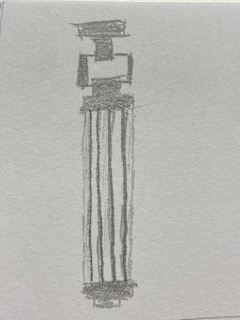

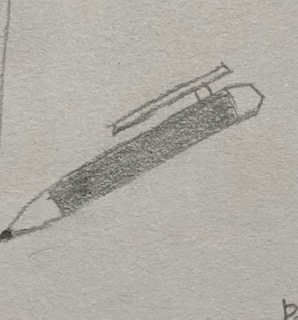

Wall/Ceiling Light:
For the aesthetic of the ship in the game, we decided for the lights to all be halogen light tubes. With one of the game students, we looked up reference images for fixed wall lights and we ended up finding one we really liked, so I went ahead and started making it. It was comprised of two exposed light tubes running through the middle with a control panel and visible bolts for it to be attached to the wall. The reference was much higher poly than how are game was meant to be, so obviously I simplified the model for my own version.
Reference My Version
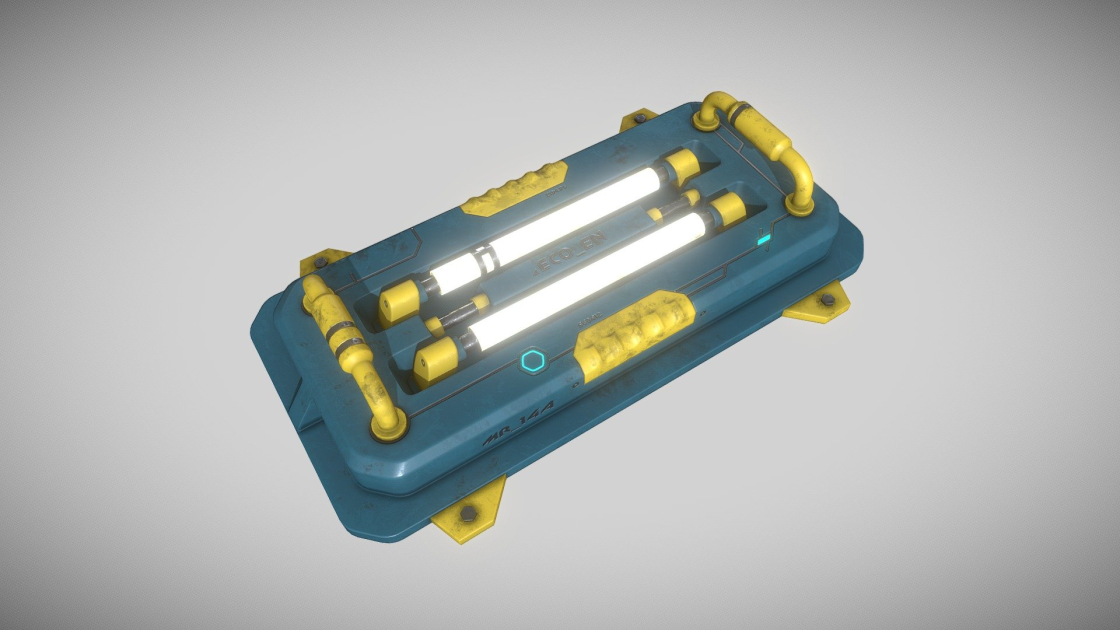

Hanging Light:
For this hanging light asset, I went the same route as the fixed wall light, in terms of color and halogen light bulbs. Fairly simple design, just a small unit that connects to the ceiling and then a hook attached to the long light consisting of two halogen bulbs.
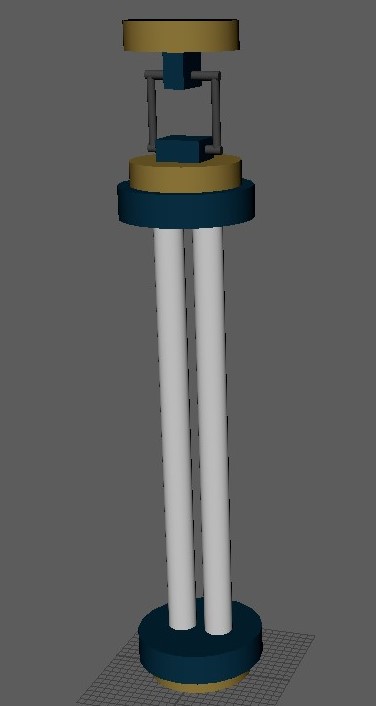
Specimen Jar:
Not much to say about this asset. The science and biology labs needed jars to hold things for the scientists to experiment on. I made a tall and wide cylindrical jar with a flat base, perfect for holding and growing plant specimens.
Jar with Plant:
Speaking of the jar being perfect for holding plant specimens, I made a plant that would fit inside the jar. I made a pretty basic flower, taking reference for design and color from a common white and yellow daisy. This asset was probably the most trouble I had out of all of them as for some reason I found it difficult to make low poly petals that didn’t just look like squares, but I got there in the end and it turned out pretty good.
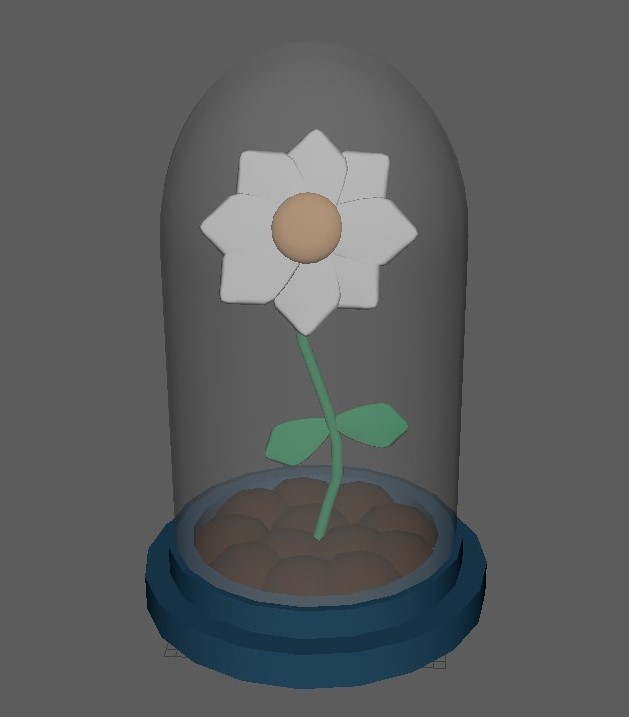
Monitor:
This asset speaks for itself, the ship needed computer monitors so I made just that. I didn’t use any researched reference as I made this asset on campus so just used the actual monitor I was staring at a the reference. The only difference being I added a small web cam at the top and an array of buttons near the bottom.

Oxygen/Gas Tank:
I originally made a whole unit with a door and control panels and pipes leading to multiple gas tanks, but the game guys decided they didn’t want it and would prefer just a tank on its own which could be used throughout the game, so I got rid of all the other stuff so I was just left with a gas cannister with a nozzle on the side and big round handle on the top.
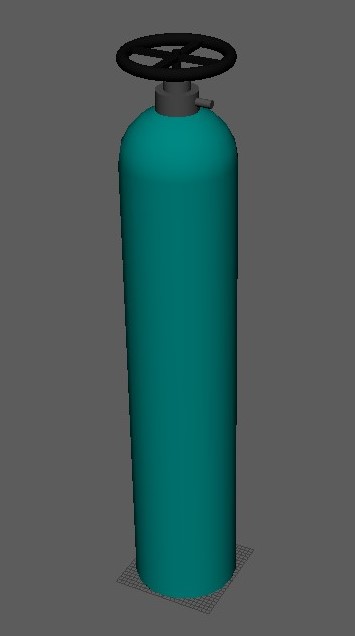
Pen:
Not much to say about this one. One of the items of clutter we needed for around the desks in the game was pens, so I made a ball point pen that was slightly on the fancier side (much nicer and thicker than a usual Bic) but still a fairly standard pen.
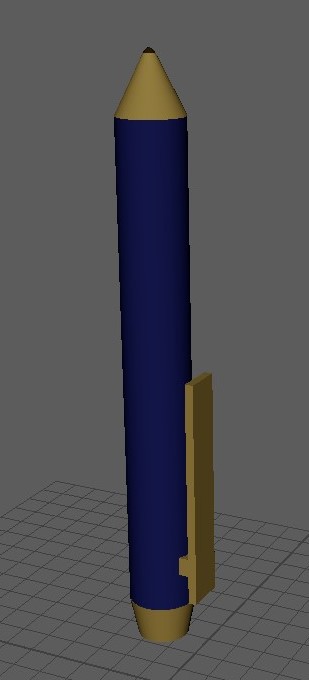
One issue I had when making models ties in with me mentioning earlier “SPECIFIC” roles. There were a few occasions were I we would go to make another asset, such as a weapon or stationary item, to find that one of the game students had made it and ticked it off the asset list “out of boredom.” Fair enough they are eager to provide for the group but we specifically set roles for a reason. If you are designing levels or working on UI then leave the modelling to the modelers, because now we have less to show for the project and it is not like we can reciprocate the “help” as we have zero knowledge in the area of constructing the inner workings of the game.
Throughout the project there were some enriching moments for me, especially in Maya as I mentioned before with making multiple different UV sets on the same model and also picking up a couple of different techniques here and there while working with Leo from the games course, who was a pleasure to work with as he helped me a lot with these UVs and other aspects of Maya. At the beginning of this project I was very invested and actually excited to be a part of making a game and seeing all of my work in action in the completed demo. I gave the work my best efforts but despite this as the weeks went on it began to feel like more and more of a chore. Mostly due to the fact that it didn’t feel like a partnership with the game students. Most of us in animation agree that working with the game students just felt like we were their assistants and had to do everything they told us. We should have had almost full creative control of the game but the game ones would just not accept most of the initial ideas and assets presented and would always pick them apart and want everything re-done so it would suit their liking. Of course it was their project too so they were allowed to have a say, but they always had too much of a say and given that they held the most power in the sense that they could pick and choose what made it into the game as they have more experience in that field we mostly found ourselves just doing what they needed. Overall, I’d say I enjoyed the individual aspect as I enjoy modelling in 3D and getting to create a variety of different assets, but as a whole I would most likely never want to partner to work with the game students again.